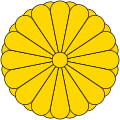Freedom and People's Rights Movement
Appearance
This article needs additional citations for verification. (July 2014) |
| This article is part of a series on |
| Liberalism in Japan |
|---|
 |

The Freedom and People's Rights Movement, Liberty and Civil Right Movement, Free Civil Right Movement (自由民権運動, Jiyū Minken Undō) (abbreviated as Freedom Party (自由党, Jiyūtō)civil rights, and the reduction of centralized taxation.[4]
The Movement prompted the Meiji government to establish a constitution in 1889 and a diet in 1890; on the other hand, it failed to loosen the control of the central government and its demand for true democracy remained unfulfilled, with ultimate power continuing to reside in the Meiji (Chōshū–Satsuma) oligarchy because, among other limitations, under the Meiji Constitution, the first election law enfranchised only men who paid a substantial amount in property taxes, as a result of the Land Tax Reform in 1873.
Related people
- Chiba Takusaburō, author of the "Itsukaichi constitution" (五日市憲法), a draft constitution for the Empire of Japan
- Etō Shinpei
- Fukuda Hideko
- Gotō Shōjirō
- Ido Reizan
- Inoue Kaoru
- Itagaki Taisuke, founder of the first Jiyūtō, and former leader of the Jinshotai
- Yamamoto Yae
- Nakae Chōmin
- Ōkuma Shigenobu
- Shimizu Shikin
- Soejima Taneomi
- Yamaji Motoharu, former Jinshotai commander
- Tokutomi Sohō
- Ueki Emori
- Soeda Azenbō, prolific enka lyricist and street performer
- Meiji period democrats, who later tried to prevent the Tripartite Pact
See also
Wikimedia Commons has media related to Freedom and People's Rights Movement.
- Liberalism in Japan
- Japanese dissidence during the Shōwa period
- Taisho Democracy
- General Election Law- the law which granted all males aged 25 and over suffrage, enacted in 1925.
References
- Sims, Richard (2001). Japanese Political History Since the Meiji Renovation 1868-2000. Palgrave Macmillan. ISBN 0-312-23915-7.
